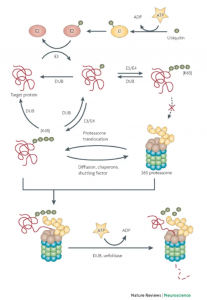This summer I will be investigating Rad6’s role in the fermentation and cellular respiration metabolism of yeast. Now, you may be wondering how this is relevant, why this is interesting, or why you should care. Let me give you some background.
As a reminder, I am working at the Silva Lab which focuses on protein and ribosomal ubiquitination in response to stress! Ubiquitin is a very important and highly conserved small protein in the cells of all eukaryotic organisms. Ubiquitin’s function is well…ubiquitous. It has many functions in many places throughout the cell, but the one you have probably heard of is protein degradation, where ubiquitin is used to flag proteins that need to be degraded by the proteasome, perhaps because they have been damaged or are no longer of use to the cell. Findings suggest that a large array of neurodegenerative diseases show aggregates of ubiquitin-flagged proteins (Tai and Schuman 2008). This indicates how important ubiquitin pathways are for the function of neurons! Ubiquitin is an incredibly important protein and it serves a prominent role in translation (one the lab is focused on elucidating) when cells are exposed to oxidative stress.
One of the lab’s main proteins of interest is called Rad6 in yeast. Rad6 is a ubiquitin-conjugating enzyme or an E2 (for those that are relatively familiar with ubiquitination). It’s involved in all sorts of pathways, such as chromatin silencing at telomeres, protein degradation, histone ubiquitination, and DNA repair. Its homolog in humans is called UBE2A and its malfunction is linked to several diseases, including X-linked intellectual disability type Nascimento and Late-Onset Parkinson’s.
Back to my research project. Why am I investigating Rad6 in the context of yeast? Well, yeast are one of the few organisms that prefer fermentation over cellular respiration. They can switch their cellular metabolism to cellular respiration depending on their environment. Before I came along, the lab found some interesting and unusual observations (more on that in my upcoming chalk talk) in the rad6∆ strain of yeast when it is in fermentation. In addition, mutations in the human UBE2A protein that lead to X-linked intellectual disability type Nascimento were found to affect the function of mitochondria in neurons (Verstreken et al. 2013). As you know, mitochondria are pretty important for cellular respiration! My job will be to take these initial observations and see if I can try to figure out what is going on here. Whatever findings result from this project, I am truly excited to contribute to the lab’s overarching goal of investigating Rad6 and ubiquitination during oxidative stress!

